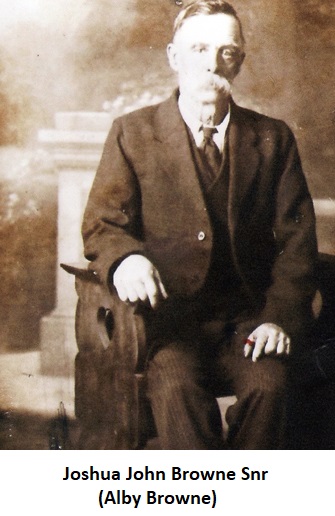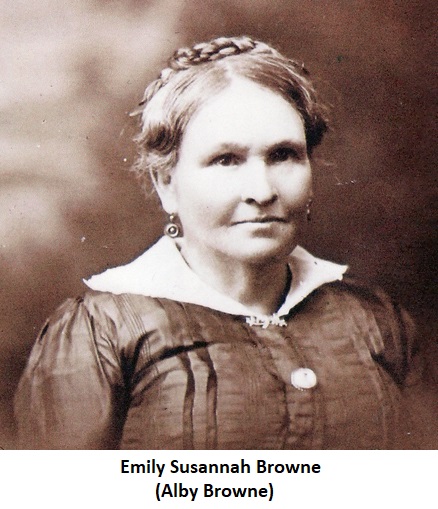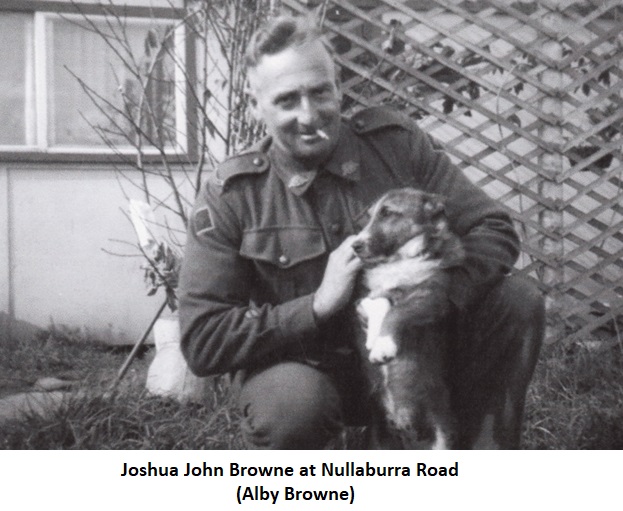
JOSHUA JOHN (1853--1928) and EMILY (1860--1946) BROWNE
Two Joshuas of All Trades


Before 1809, Joshua and Emily Browne moved their home
which they built, from Kogarah Bay to Gannons Road,Cronulla, in the literal
sense. Joshua was in his 50s and some of their 11 children made the move with
them.
Joshua John
Browne was a resourceful man. He was engaged in oyster farming and limeburning
in the southern region of
Botany Bay
near the mouth of the
Georges
River.
He also had horses and drays and felled trees for firewood, a very lucrative
commodity in the days preceding electricity. Joshua began supplying timber for
the city bakers and the demand meant Joshua was looking further afield for his
supply of timber. Across the
Georges
River,
south of the shores of
Botany Bay and toward Curranulla Road
(later the Kingsway) he found a forest of white gums which would satisfy the
demand for cut firewood. It was decided to move their house from Kogarah Bay
to the other side of the river. The house was dismantled into sections and
loaded onto the timber jinker that Joshua used for carting huge tree logs.
Crossing the
Georges River
at Tom Ugly’s with a team of horses and laden jinker could have posed a problem
to some, but Joshua found an alternate route. He drove his team of horses to the
punt crossing at Lugarno,
along the Old Illawarra Road crossing the
Woronora River at Woronora Ford (the Needles) continuing on to meet the Princes
Highway (Illawarra Road) between Engadine and Heathcote then to Sutherland and
finally to the corner of Gannons and Curranulla Road at Cronulla. The house was
rebuilt on the site where the Jenola hockey field is today. Later the house was
again moved but this time it was only a short distance northwards along Gannons Road.
Its final resting place was on the western side of Gannons Road
on a double block of land opposite the northern boundary of Woolooware Golf
Course.
The weatherboard house
consisted of four rooms, a living room, a dining room and two bedrooms. At
Gannons Road a
verandah was built on the front and over the years a large peppercorn tree
shaded it. The obligatory lean to verandah with only a dirt floor was built on
the back of the house to accommodate the cooking area. A well was dug at the
back of the house in which Emily’s grandson, Alby Browne remembers an encounter
with a large snake. His Grandmother sent him to get the rifle and while Alby
thought he was taking careful aim, Emily, who was now in her 80s and had a glass
eye whipped the rifle from his hands and shot the snake in an instant. Water for
domestic use was of course from a rainwater tank positioned at the back door
conveniently for Emily to fill the kettle. Some household provisions not
obtainable at Cronulla could be had by walking to Taren Point then taking a
launch to Sans Souci.1
Joshua John Browne was born
at
Newtown in 1853 to John
Browne and
Elizabeth
nee Parker. Emily Susannah Smith was born in 1860 at Botany, the daughter of
William Smith, an oyster farmer. Emily’s grandson, Alby Browne was told that
Emily worked for her father up to her neck in water, collecting oysters from the
river near
Como.
Emily married Joshua when she was 15 years old on Christmas Eve 1874 at St Paul’s
Church of England, Kogarah.
Joshua and Emily had 11
children. Eliza Blackford was their first born in 1876. She married Peter
Hooley. Frederick David was born in 1879 and married Edith Dawson. The third
child George was born in 1882 and died in 1884. Emily Matilda, who married
Walter Hannon, was born in 1884, then Florence 1887-1891, William in 1890
(married Clarice Anderson), Ethel Maude in 1893 (married George Miller, Tom in
1895 (married Jessie Cross), Joshua John in 1898 (married Frances Cross), Jack
who died in infancy, and Harry in 1902 who married Isabel Emerson.2
Some of their children moved with them to Cronulla.
Joshua John Browne lived a
long and hard working life. He was cutting timber and carting until the day he
died on
9 August 1928
at his home in Gannons Road.
His wife Emily continued to live in the
Gannons Road
house with her youngest son Harry. The older children were married and had homes
of their own. Tom and his wife Jessie, and Eliza and her husband Peter Hooley
also lived in homes in
Gannons Road.
Ethel and husband George Miller lived at Caringbah on the corner of
Jacaranda Road
and the Kingsway. Joshua's (junior) son Eric who was born in 1920 at Bexley
lived for some time with Emily while he was growing up. He was company for Emily
while her grown sons were away working. Emily died at the age of 86 on
6 August 1946
at her home and was buried with her husband in the Anglican section of Woronora
cemetery.
Joshua and Emily’s ninth
child, also named Joshua John pursued the same occupations as his father. He was
engaged in both limeburning and timber carting and other occupations during his
working life. Joshua John junior was born at home in Lacey Street,
Kogarah Bay
on 28 November 1898.
After marrying Frances Ethel Cross at St David’s Church of England, Arncliffe,
the young couple lived at Bexley where their children Albert Charles (Alby),
Eric, Jack and Audrey were born.

For a few years
the family lived in a house on Port Hacking Road,
Miranda. The property was situated a few hundred metres east of George
Thorgood’s gardens and became known as the horse paddock as Joshua’s team of
horses were a familiar sight there. Trucks and buses began to take over from
horse power and when an opportunity arose to operate a bus route at Cessnock,
Joshua and family moved again. The buses were ‘parlour cars’ or ‘parlour
coaches’ similar to a flat top truck with a canopy over it and seats along both
sides so that passengers faced each other. The buses transported miners to work
but the miner’s strike of 1928 put an end to this venture.
Joshua brought his family
back to Caringbah, finding a home in Wallamatta Road
which was at the rear of his parents’ home in
Gannons Road.
He began working with his brother Harry who had a sawmilling business for
cutting timber for domestic use. When work slowed in the timber cutting trade,
Joshua John turned to other employment. He worked for the Marine Shell Company
dredging cockle shell from the bottom of the river at Port Hacking. The shell
was transferred from the dredge to the wharf and loaded onto an elevator which
conveyed the shell up the hill to
Fernleigh Road
where it was bagged on site. It was then loaded onto trucks and transported to
Warne’s Lime Company in Ricketty Street,
St Peters.
It was hard and dirty work but there was a bonus of fresh fish for tea. While
the dredge exhumed the cockle shell it also sucked up some good fish dinners.
In 1936, construction began on the Sutherland to
Cronulla railway. Joshua was employed as a truck driver but the overseer gave
his job to his son Alby because Alby could be paid a lower wage. Alby had learnt
to drive at the age of 10 on the buses in Cessnock.
After serving four years with
the Army during World War II, Joshua returned home and was able to purchase his
home in
Nullaburra Road,
Caringbah. He did contracting work with Sutherland Shire Council, supplying blue
metal for upgrading of the many dirt roads in the Shire. Large blocks of land
which had previously been market gardens and poultry farms were now being
subdivided for building blocks and new roads were part of this infrastructure.
Like his father, Joshua John Browne had lived a long and hard working life,
providing for his family in whatever employment was available. He died on 18 October
1972 and was cremated at Woronora
Crematorium.3
Sue Hewitt
First published in
Sutherland Shire, Some Early Residents, 2006,
by Botany Bay Family History Society. Compiled by
Maree McKinley and Sue Hewitt.
Click on the name
JOSHUA JOHN (1853—1928) and EMILY (1860—1946) in
the heading of this story. You will be taken to the database entry for Joshua
John and his family.
Endnotes:
1.
St George and Sutherland Shire Leader 13 Dec 1972
2.
Research by Terry Browne
3.
This story is based on interviews with Alby Brown, Feb 2007




